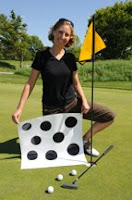Here are some quotes we have all heard (or said ourselves) on the golf course or at the ball diamond.
On a good day:
"It was like putting into the Grand Canyon"
"The baseball looked like a beach ball up there today"
On a bad day:
"The hole was as small as a thimble"
"I don't know, it looked like he was throwing marbles"
The baseball and the golf hole are the same size every day, so are these comments meaningless or do we really perceive these objects differently depending on the day's performance? And, does our performance influence our perception or does our perception help our performance?
Jessica Witt, an assistant professor of psychological science at the University of Virginia has made two attempts at the answer. First, in a 2005 study, "See the Ball, Hit the Ball", her team studied softball players by designing an experiment that tried to correlate perceived softball size to performance. She interviewed players immediately after a game and asked them to estimate the size of the softball by picking a circle off of a board that contained several different sizes. She then found out how that player had done at the plate that day. As expected, the players that were hitting well chose the larger sized circles to represent the ball size, while the underperforming hitters chose the smaller circles. The team was not able to answer the question of causality, so they expanded the research to other sports.
Fast forward to July, 2008 and Witt and her team have just released a very similar study focused on golf, "Putting to a bigger hole: Golf performance relates to perceived size". Using the same experiment format, players who had just finished a round of golf were asked to pick out the perceived size of the hole from a collection of holes that varied in diameter by a few centimeters. Once again, the players who had scored well that day picked the larger holes and vice versa for that day's hackers. So, the team came to the same conclusion that there is some relationship between perception and performance, but could not figure out the direction of the effect. Ideally, a player could "imagine" a larger hole and then play better because of that visual cue.
Researchers at Vanderbilt University may have the answer. In a study, "The Functional Impact of Mental Imagery on Conscious Perception", the team led by Joel Pearson, wanted to see what influence our "Mind's Eye" has on our actual perception. In their experiment, they asked volunteers to imagine simple patterns of vertical or horizontal stripes. Then, they showed each person a pattern of green horizontal stripes in one eye and red vertical stripes in the other eye. This would induce what is known as the "binocular rivalry" condition where each image would fight for control of perception and would appear to alternate from one to the other. In this experiment, however, the subjects reported seeing the image they had first imagined more often. So, if they had imagined vertical stripes originally, they would report seeing the red vertical stripes predominantly.
The team concluded that mental imagery does have an influence over what is later seen. They also believe that the brain actually processes imagined mental images the same way it handles actual scenes. "More recently, with advances in human brain imaging, we now know that when you imagine something parts of the visual brain do light up and you see activity there," Pearson says. "So there's more and more evidence suggesting that there is a huge overlap between mental imagery and seeing the same thing. Our work shows that not only are imagery and vision related, but imagery directly influences what we see."
So, back to our sports example, if we were able to imagine a large golf hole or a huge baseball, this might affect our actual perception of the real thing and increase our performance. This link has not been tested, but its a step in the right direction. Another open question is the effect that our emotions and confidence have on our perceived task. That hole may look like the Grand Canyon, but the sand trap might look like the Sahara Desert!
Witt, J.K. (2008). Putting to a bigger hole: golf performance relates to perceived size. Psychonomic Bulletin&Review, 15(3), 581-585.






Comments